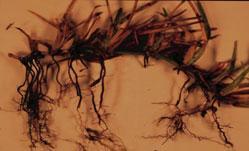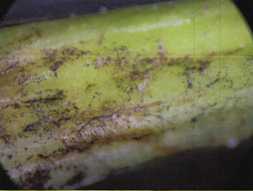Spring Hill Lawn Services - Take All Root Rot
What is it?
Take All Root Rot, or TARR, is a soil born pathogen found in all Florida soils. It is not a surface fungus and cannot be transmitted by air or by walking across it or mowing the lawn. Take All Root Rot can be found throughout Brooksville, Spring Hill, Weeki Wachee, Dade City, Land O' Lakes, New Port Richey, Wesley Chapel, Zephyrhills, Crystal River, Homosassa, Inverness and the surrounding areas.
What does it do?
It attacks the root system and essentially shrivels it up so that it cannot provide the nourishment that the grass plant needs to survive.
What causes it to attack?
The conventional wisdom is that it is stress. Stress is defined as too much water, too little water, surface fungus, chinch bugs, traffic, cold damage, etc. We are sure that all of this is causal, but it does not explain why two lawns side by side with similar stress will have one lawn attacked and another not.
How do I know I have it?
Take All Root Rot is the most under diagnosed problem in the lawn industry. What you see is a yellowing of the grass, then a browning and then entire dead sections. This also describes what you see with chinch bugs and brown patch fungus. Unfortunately what commonly occurs is chinch bugs are found in a deteriorating area. What is important to understand is that it takes 25 chinch bugs per square foot to be detrimental to your lawn. If a chinch bug is found, then the problem is assumed to be chinch bugs and a treatment is applied even though the numbers are well below the damage level. The treatment kills the existing chinch bugs, but the lawn continues to deteriorate. The assumption is that this is residual chinch bug damage when it is actually Take All Root Rot
There are some indicators that we look for, such as roots which are shriveled and have little or no elasticity. (Quality roots are long, white and are elastic.) Also the nodes on the stolen (runner) are usually black. But, the only way to tell is to pull samples and look at them under a microscope.
 |
 |
| Picture courtesy of Dr. Stacy Strickland, U of F Hernando County Extension Center | Picture Courtesy of U of F/ IFAS |
This is what we see under the microscope if TARR is present Notice the fine lace like lines similar to connect the dot or road map. This is TARR.
How do I cure it?
You can’t, but it can be managed. The last thing you want to do is replace sod and 8 months later be looking at replacing the sod again. We manage the problem by treating with fungicides that are labeled for Take All Root Rot. We also train you to look for signs that it is turning on again. When we treat it early on, it goes into “remission” and damage is kept to a minimum. In most cases, the damage will recover. It has been our experience that Take All Root Rot re-occurs in the same places year after year. That is why vigilance is so important!
Is it worth my time to re-sod?
Absolutely! Remember in years past you have treated the wrong thing, in the wrong way. Your re-sodded area will get Take All Root Rot again. But, with your vigilance and our help, you can maintain a beautiful lawn!
